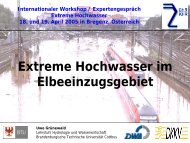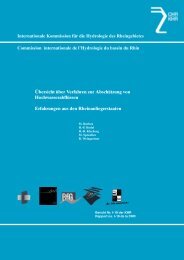ABSTRACTS 'Extreme Discharges' - CHR-KHR
ABSTRACTS 'Extreme Discharges' - CHR-KHR
ABSTRACTS 'Extreme Discharges' - CHR-KHR
Create successful ePaper yourself
Turn your PDF publications into a flip-book with our unique Google optimized e-Paper software.
the tributaries of the Rhine exceed the 1,250 year design discharge, i.e. 16,000 m 3 /s, near the Dutch-German<br />
border at Lobith. So, even though at Lobith the maximum observed discharge is “only” 12.500 m 3 /s, the relevant<br />
hydrological processes that occur during a 16,000 m 3 /s event possibly have been observed on a more local<br />
scale. This means a relatively good estimate of model uncertainties can be obtained by comparing observed and<br />
simulated discharges. First enquiries were executed to do this quantification with the so-called “GLUE”-method<br />
in which uncertainties (likelihoods) in parameter estimates are based on the goodness-of-fit of observed and<br />
simulated hydrographs. In this method a large number of optional parameter sets are then used in model predictions,<br />
and model outcomes are weighted according to the associated likelihood. From this ensemble of weighted<br />
model outcomes the mean and uncertainty bounds can be evaluated (see e.g. Figure 2).<br />
Special focus in this process is needed for the hydraulic component of the model. During design flood conditions<br />
long stretches of the river network are confronted with discharges that exceed the highest observed discharges<br />
by far. Therefore we need to know [a] at what stage floods will occur and [b] which amount of water<br />
will be lost. Even though no data on these type of extreme floods is available, the physical processes involved<br />
are quite well-known. Hydraulic model simulations can therefore provide valuable information. However, this<br />
requires detailed information on cross sections, dikes and flood plains along all stretches of the basin. This may<br />
still take a huge effort but it will pay off eventually. The physical boundaries of the river network may well reduce<br />
the effects of uncertainties of the rainfall generator and rainfall-runoff model on the final outcome.<br />
41





